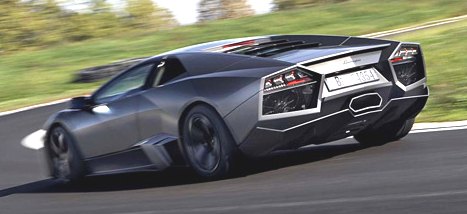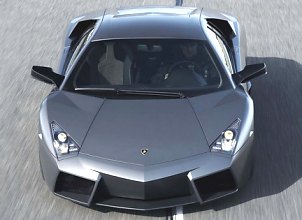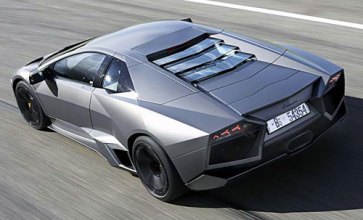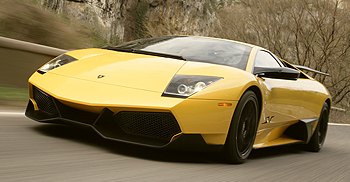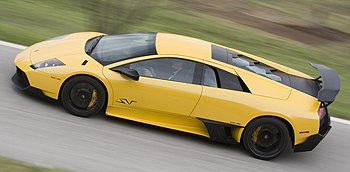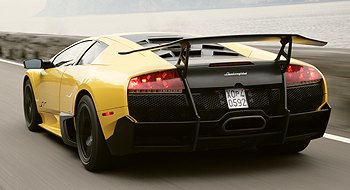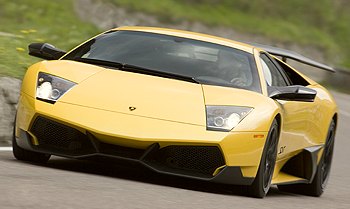Lamborghini Murcielago
Debut: 2001 |
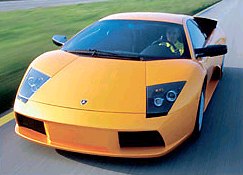 Despite
of 27 years separating them, Countach and Murcielago are surprisingly
similar.
Take the drivetrain as an example, the V12 was evolved from the same
origin
without major re-think, the gearbox still sits inside the central
tunnel
and in front of the mid-mounted engine, which is still a unique feature
of Lamborghini. From outside, you'll also notice the similarity between
them. Although the new Murcielago has most sharp edges smoothened, the
profile is still recognizably Countach-inspired. Plug the Diablo into
the
empty space between them and you'll see a clear picture of evolution. Despite
of 27 years separating them, Countach and Murcielago are surprisingly
similar.
Take the drivetrain as an example, the V12 was evolved from the same
origin
without major re-think, the gearbox still sits inside the central
tunnel
and in front of the mid-mounted engine, which is still a unique feature
of Lamborghini. From outside, you'll also notice the similarity between
them. Although the new Murcielago has most sharp edges smoothened, the
profile is still recognizably Countach-inspired. Plug the Diablo into
the
empty space between them and you'll see a clear picture of evolution.The new Lamborghini was styled by Audi designer Luc Donckerwolcke. Before this, the Belgium has Audi A2 and Skoda Fabia under his name. But that appears nothing to design master Marcello Gandini who styled simply all previous Lamborghini supercars. Personally, I think the new design is too conservative by the standard of Lambo. Perhaps too refined as well. However, those having seen the Zagato running prototype must agree with Dr. Piech's decision to have a last-minute restyle by another one. We'll never know whether Mr. Donckerwolcke's proposal is better than his competitor in Bertone, because we will never see the latter, but it could be disappointing to many hardcore enthusiasts that the new Lamborghini was not designed by an Italian. I know the last Diablo 6.0 was also penned by Donckerwolcke, but that was just an insignificant facelift. 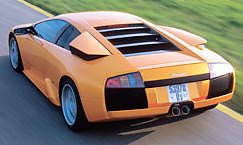 The
highlight of the new design is purity. To certain extent it brings back
the purity of the early Countach prototype - before cooling and
aerodynamics
requirements ruined the design. Audi-grade body panels and narrow
assembly
gaps is one to accounted for its purity, a pair of neat pop-up cooling
ducts is another. These air intakes locate behind the rear quarter
windows,
or where the Countach had its NACA ducts. When the car is at rest, they
recess smoothly into the body so that photographers will only see its
most
beautiful form. When the car is running at high speed, they don't pop
up
either, because air flow is strong enough to cool the engine. In this
way,
aerodynamic drag remains low. They only pop up and increase intake area
by up to 80% when the car is running slowly, sticking in traffic or
outside
temperature is above 32°C. That means here in South-East Asia we
are
unlikely to see its purist form during the whole summer. But in case
you
like this playful function, you can press a button and show your guest
- ah ! what a supercar ! The
highlight of the new design is purity. To certain extent it brings back
the purity of the early Countach prototype - before cooling and
aerodynamics
requirements ruined the design. Audi-grade body panels and narrow
assembly
gaps is one to accounted for its purity, a pair of neat pop-up cooling
ducts is another. These air intakes locate behind the rear quarter
windows,
or where the Countach had its NACA ducts. When the car is at rest, they
recess smoothly into the body so that photographers will only see its
most
beautiful form. When the car is running at high speed, they don't pop
up
either, because air flow is strong enough to cool the engine. In this
way,
aerodynamic drag remains low. They only pop up and increase intake area
by up to 80% when the car is running slowly, sticking in traffic or
outside
temperature is above 32°C. That means here in South-East Asia we
are
unlikely to see its purist form during the whole summer. But in case
you
like this playful function, you can press a button and show your guest
- ah ! what a supercar !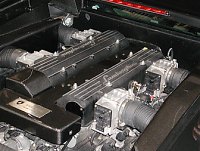 Forget
that silly thing. The focus of Lamborghini is still that thundering
V12,
now bigger than ever thanks to a stroke-out to 6192 c.c.. But 200 more
c.c. alone is not enough for a new-age Lamborghini, so it also gets a
new
3-stage variable geometry intake manifold and exhaust valve variable
timing
(in addition to the existing intake VVT). The variable intake was only
ever used in the very secret Diablo Jota. Although press release did
not
mention, you can expect other technology carries over from the last
Diablo
6.0, including magnesium cam cover and manifolds, titanium connecting
rods,
individual drive-by-wire throttles and 2-stage back-pressure exhaust
system. Forget
that silly thing. The focus of Lamborghini is still that thundering
V12,
now bigger than ever thanks to a stroke-out to 6192 c.c.. But 200 more
c.c. alone is not enough for a new-age Lamborghini, so it also gets a
new
3-stage variable geometry intake manifold and exhaust valve variable
timing
(in addition to the existing intake VVT). The variable intake was only
ever used in the very secret Diablo Jota. Although press release did
not
mention, you can expect other technology carries over from the last
Diablo
6.0, including magnesium cam cover and manifolds, titanium connecting
rods,
individual drive-by-wire throttles and 2-stage back-pressure exhaust
system.Although the V12 now has more displacement than the mighty McLaren F1, its maximum output of 580hp lags behind the latter by almost 50 horses. In fact, 93.7 horsepower-per-litre is not very special for this kind of cars. Even compare with Diablo 6.0, it gains just 30 horsepower - you know, that is just a small percentage for a 500-plus-horsepower engine. When measure against the limited edition Diablo GT, its advantage is further narrowed to just 5hp. However, the new engine is far more torquey and tractable, which is not very surprising if you remember that we have talked about longer stroke and new variable intake manifold. At just 2000rpm it produces a full 400lbft. That increases to the peak 479 lbft at 5400rpm. Moreover, it complies with the strict EU4 emission regulations, so compare with the old McLaren seemed unfair. 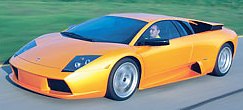 Now
it seems that we have forgotten the body and chassis - what Lamborghini
men always see as no more than an engine cover. Size-wise, it grows a
bit
in wheelbase (15mm) and height (25mm) to accommodate a larger cockpit,
which was the most criticized item for decades. The whole body is 110
mm
longer but just 5mm wider than the already exaggerate 2040mm. Place it
on a scale, without any fuel, fluid and occupants, it reads 1650 kg, 25
more than before. Inspect the materials list - the chassis is still
steel
tubular space frame like 27 years ago; the whole body excluding roof
and
doors are carbon fiber, just like the last Diablo, but now some of them
contribute to chassis strength as well, so the chassis is noticeably
stiffer;
as before, the roof is steel, but I wonder why now the doors are
relegated
from aluminium to steel. You know, Audi is not renowned for steel. Now
it seems that we have forgotten the body and chassis - what Lamborghini
men always see as no more than an engine cover. Size-wise, it grows a
bit
in wheelbase (15mm) and height (25mm) to accommodate a larger cockpit,
which was the most criticized item for decades. The whole body is 110
mm
longer but just 5mm wider than the already exaggerate 2040mm. Place it
on a scale, without any fuel, fluid and occupants, it reads 1650 kg, 25
more than before. Inspect the materials list - the chassis is still
steel
tubular space frame like 27 years ago; the whole body excluding roof
and
doors are carbon fiber, just like the last Diablo, but now some of them
contribute to chassis strength as well, so the chassis is noticeably
stiffer;
as before, the roof is steel, but I wonder why now the doors are
relegated
from aluminium to steel. You know, Audi is not renowned for steel.Although kerb weight is up, the transmission is now 6-speed instead of the ancient 5-speed while the engine is more torquey, so Murcielago still accelerates considerably quicker than Diablo. According to Lamborghini’s figure, it needs 3.5 seconds to complete 0-60mph. According to my estimation (from past experience we should never believe the official figures from Sant’Agata), it is perhaps 3.9 seconds. As long as you compare it with production supercars, especially in this price range, you won’t be disappointed. Just don’t expect it to be a McLaren or F60-beater. Lamborghini lost that ambition long ago. Top speed, strangely, is now claimed to be just 205mph, quite conservative by Lamborghini norm. Considering the smooth body with air ducts lowered has a Cd of 0.33 (though not matching Diablo’s 0.31), it can easily reach that speed. Perhaps it will be the first-ever Lamborghini to exceed its claimed top speed ... funny. 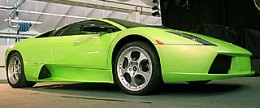 Now
about the handling department. Basically the mechanical layout remains
unchanged from Diablo 6.0. For example, the double-wishbones
suspensions
and the mandatory 4-wheel-drive system with viscous-coupling center
differential
are almost unaltered. The electronic adaptive damping and adjustable
ride
height for front wheels are still there. The ABS is improved, traction
control is added, front tyres are marginally wider, and Pirelli
specially
designed P-Zero "Rosso" for this car. The Brembo brakes, with 355mm /
335mm
discs front and rear and 4-pot calipers, are similar to the Diablo’s.
The
front to rear weight distribution is barely improved by 1% to 42:58.
However,
the biggest improvement is fine tuning all components to extract their
real potential, and to make the controls easier to live with. Now
about the handling department. Basically the mechanical layout remains
unchanged from Diablo 6.0. For example, the double-wishbones
suspensions
and the mandatory 4-wheel-drive system with viscous-coupling center
differential
are almost unaltered. The electronic adaptive damping and adjustable
ride
height for front wheels are still there. The ABS is improved, traction
control is added, front tyres are marginally wider, and Pirelli
specially
designed P-Zero "Rosso" for this car. The Brembo brakes, with 355mm /
335mm
discs front and rear and 4-pot calipers, are similar to the Diablo’s.
The
front to rear weight distribution is barely improved by 1% to 42:58.
However,
the biggest improvement is fine tuning all components to extract their
real potential, and to make the controls easier to live with.Two things might contribute quite a lot improvement to handling: 1) the engine now sits 50mm lower in chassis to improve center of gravity. We always know the high-mounted V12 was one of the main reasons for the inferior handling of Countach and Diablo, so a lowered engine comes as a good news. Oddly, press release said it is due to the use of dry-sump lubrication, but in fact both its predecessors also employed that; 2) high speed stability is improved by the use of electric rear wing. up to 130km/h, that little wing is completely recessed in body. From there to 220km/h, it is raised by 50°. Above 220km/h, it is further raised to 70°. Not the most brilliant design, but it should generate a bit positive downforce at speed. Concerning production, Lamborghini plans to build 400 cars annually. There will be a Roadster version, but not a RWD version. Just as a prediction, I think in the second-half of its life more special editions will appear, what about a new SV, SE40 or GT ? Did I miss something ? oh yes, the name Murcielago is named after a brave bull which was spared by a famous matador in 1879. Of course, it’s a Spanish word (like Diablo). It pronounces like "more thea lago". Now let’s open the door to see how it perform... On The Road Take notes: Autocar’s Stephen Sutcliffe said the Murcielago looks far more beautiful in metal (or carbon ?) than in photo. Next time you and I see it on road, we can verify that. However, we can’t help amazing how high quality the body panels are. No matter fitness and paint, it qualifies the highest standard set by Dr. Piech. Perhaps better, because carbon-fiber is hard to control. 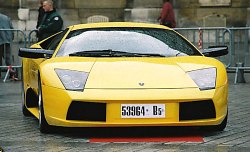 Swing
up the spectacular scissors door, you see the best ever Lamborghini
interior.
While the design by Audi designer Ralph Kluge is not special, it feels
expensive. The foolish carbon fiber dash of the previous Diablo 6.0 has
gone (I am still wondering how much weight it saved), replaced with a
simple,
elegant and leather-clad one. Although it could feel a bit
Germanic-cool
rather than Ferrari’s Italian-classic, its switches and buttons are
tailor-made
and feel good to touch. Ferrari, in contrast, still employs some Fiat
switches.
Admittedly, the mirror controls and a few other switches come from
Audi,
but then again Audi is not Fiat. Swing
up the spectacular scissors door, you see the best ever Lamborghini
interior.
While the design by Audi designer Ralph Kluge is not special, it feels
expensive. The foolish carbon fiber dash of the previous Diablo 6.0 has
gone (I am still wondering how much weight it saved), replaced with a
simple,
elegant and leather-clad one. Although it could feel a bit
Germanic-cool
rather than Ferrari’s Italian-classic, its switches and buttons are
tailor-made
and feel good to touch. Ferrari, in contrast, still employs some Fiat
switches.
Admittedly, the mirror controls and a few other switches come from
Audi,
but then again Audi is not Fiat.The driver still struggles to get inside, the seats are still mounted right on the floor, but ergonomics are much improved. Firstly, the driving position is more natural. Secondly, the pedals and steering wheel is less offset towards the center. Thirdly, there is more legroom, headroom (40mm) and shoulder room (25mm). The 6-footers previously rejected by the Diablo now sits happily in the Murcielago. Lastly but not least, the small and beautiful Momo steering wheel is fully adjustable. Press the start button, the 6.2-litre V12 idles smoothly. Sound and thrust are not specially strong below 3500rpm, but throttle response is obviously sharper. Up-shift the 6-speed transmission and you’ll find the first (of many) improvement in drivability - although not light by usual standard, it is more manageable than its two predecessors. The clutch is also lighter. 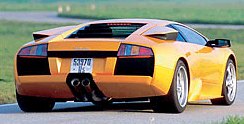 Enter
4000rpm, the V12 comes into life, roaring and surging into its
tremendous
power band. You’ll feel that explosive power is another level from the
Diablo, yet the noise remains truly Lamborghini - raw, mechanical and
loud.
Enter 6500rpm its full song becomes thundering loud, so breathless and
so entertaining ! this goes on until the rev limiter is hit at
7800rpm. Enter
4000rpm, the V12 comes into life, roaring and surging into its
tremendous
power band. You’ll feel that explosive power is another level from the
Diablo, yet the noise remains truly Lamborghini - raw, mechanical and
loud.
Enter 6500rpm its full song becomes thundering loud, so breathless and
so entertaining ! this goes on until the rev limiter is hit at
7800rpm.Now turn into a bend. The nose points precisely to where you steer. Steering feel is still on the heavy side, but more communicative and responsive. Apparently, the stiffened and fine-tuned chassis has tamed the wild bull with far better balance and agility. Push it for a few laps more, you’ll realize the new Lamborghini feels smaller and lighter than it is. The Diablo used to feel big and bulky in corners, had to apply that "slow-in, fast-out" technique; the Murcielago feels a proper sports car now. It changes direction crisply yet fluently. It grips harder and stops quicker. More importantly, it is far more forgiving to errors. If you enter a corner too quick and brake hard, its tail will remain planted. The old car ? you’ll end up in gravel facing the opposite direction. It is this kind of forgiving manner that raise confidence of pushing the car to its performance envelop, enjoying its deep-reserved potential more frequently. 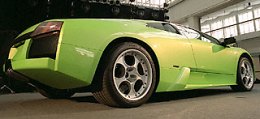 Nevertheless,
the bull still fail to match the agility of real sports cars like
Ferrari
360 Modena and Porsche 911GT3. These cars can be pushed even harder.
They
will powerslide without drama and still feel entertaining. In contrast,
the big Lamborghini is still somewhat handicapped by its actual
dimension
and weight. Nevertheless,
the bull still fail to match the agility of real sports cars like
Ferrari
360 Modena and Porsche 911GT3. These cars can be pushed even harder.
They
will powerslide without drama and still feel entertaining. In contrast,
the big Lamborghini is still somewhat handicapped by its actual
dimension
and weight.The Murcielago really feels much faster than the Diablo, although we are still waiting for the first set of test data. However, it is undoubtedly far more user-friendly than the Diablo. Steering, clutch and gearchange are all lighter to operate. Ride quality is also superior. Build quality and cabin comfort are vastly improved. Now driving the big Lamborghini is no longer a painful experience. At the same time, its performance is more accessible, thanks to much better handling. We are pleased to see it improves in every area, satisfying the requirements of comfort as well as driving fun. We didn’t expect that, but new owner Audi really polished the Italian diamond, making it more desirable than ever. Of course, subjectively speaking, the Countach remains to be the greatest Lamborghini of all time. The Murcielago doesn’t innovate anything, it just releases the full potential of the forward-thinking Countach which set out those formulas some 27 years ago. |
| The above report was last updated on 4 Nov 2001. All Rights Reserved. |
Murcielago LP670-4 SV
|
||||||||
Many believe this could be the final version of Murcielago. LP670-4 SV (Super Veloce), as its name suggested, boosts 670hp (up 30hp), retains 4-wheel drive and is Super Fast, of course. It is a limited edition run of 350 cars, although that amount is enough for a full year’s production of Murcielago series. To secure one of them, you have to pay a premium of 25-30 percent over the standard LP640. Following the tradition of SV (which began with Miura and last appeared in Diablo), LP670-4 SV achieves higher performance from 3 areas – higher tuned engine, weight reduction and increased downforce. We start from the latter. You can easily identify a LP670-4 SV by its aggressive aerodynamic aids. Up front it has more pronounced air splitters around the enlarged cooling intakes. At the back are two large diffusers. At both sides there are larger skirts and air intakes, both are left unpainted in black carbon-fiber. Ditto the huge carbon-fiber rear spoiler, now rigidly fixed at the tail to save weight. Lamborghini offers two choices of rear spoiler, a smaller one enables 212 mph top speed (same as LP640 yet achieves higher downforce), or a larger one produces even more downforce at the price of top speed, which is 209 mph.
Both versions accelerate faster than LP640. 0-60 mph now takes 3.1 seconds, 0.2 sec less than before. This is purely down to the more powerful engine and less weight. The V12 engine now sits under a new design bonnet made of carbon-fiber. It is visible through 3 hexagonal windows made of polycarbonate. The engine is basically the same 6.5-liter unit in the standard car, with dual-VVT and 3-stage variable intake system. However, it gets revised valve timing, higher valve lift and a new exhaust system. The result is 670 horsepower at 8000 rpm. Predictably, the more aggressive valve timing and lift does not benefit bottom end torque. While maximum value remains unchanged at 487 lb-ft, its peak arrives 500 rpm later than before.
Never mind, because the engine now needs to cope with less weight – some 100 kg has been shed, resulting in a 1565 kg dry weight. The weight reduction are evenly distributed in various areas – 20 kg from the tubular steel chassis (thanks to the use of super high-strength steel, which also increases torsional rigidity of the chassis by 12 percent), 13 kg from the bodywork (thanks to the use of fixed rear spoiler instead of electrically adjustable one, also more extensive use of carbon-fiber, which covers the whole bodywork except doors and roof which are still made of steel for crash safety), 26 kg from the engine (mainly down to lighter exhaust system), 7 kg from transmission and 34 kg from the interior. The latter includes carbon-fiber floor and transmission tunnel, carbon-fiber bucket seats, Alcantara and carbon fiber trim (instead of leather) and the lack of sound / navigation system. With air conditioning and parking camera retained, it isn't exactly a stripped out cabin. Less changes were made elsewhere. The transmission continues to be E-gear as standard, with optional 6-speed manual. Carbon ceramic brakes and Pirelli P-Zero Corsa tires are standard. No changes have been made to suspensions and traction system, so you can expect the same livable ride as LP640.
On the road, SV performs slightly better than LP640 in just any aspects. Its V12 sounds more urgent, emitting a harder-edged exhaust note under full throttle. The E-gear adds to that brutal feel with a shockwave in every gearchange. Is it faster than the standard car on straight line ? No doubt. However, more important is how good it attacks corners. With less mass to carry, the SV feels smaller than LP640 on narrow twisty roads typically found in Italy. Its turn-in is more responsive, with noticeably less understeer in the initial turn-in. The rear end is more tightly controlled, more difficult to unsettle than the standard car. SV possesses an accuracy and intimacy unfound before in the big Lambo. From power, handling and braking, there is nothing short of sensational. Think about a Ferrari 430 Scuderia with a V12 sound, 160 extra horses and four-wheel traction, it won't be far off. |
||||||||
| The above report was last updated on 28 Jun 2009. All Rights Reserved. |
| Specifications | |||||||||||||||||||||||||||||||||||||||||||||||||||||||||||||||||||||||||||||||||||||||||||||||||||||||||||||||||||||||||||||||||||||||||||||||||||||||||||||||||||
|
|
|||||||||||||||||||||||||||||||||||||||||||||||||||||||||||||||||||||||||||||||||||||||||||||||||||||||||||||||||||||||||||||||||||||||||||||||||||||||||||||||||||
|
|
|||||||||||||||||||||||||||||||||||||||||||||||||||||||||||||||||||||||||||||||||||||||||||||||||||||||||||||||||||||||||||||||||||||||||||||||||||||||||||||||||||
|
|||||||||||||||||||||||||||||||||||||||||||||||||||||||||||||||||||||||||||||||||||||||||||||||||||||||||||||||||||||||||||||||||||||||||||||||||||||||||||||||||||
| Performance tested by: *Autocar, **R&T, ***AMS, ****C&D |
Copyright©
1997-2009
by Mark Wan @ AutoZine
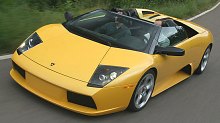 Rich
people want to be seen in supercars. That’s why Lamborghini builds
Murcielago
Roadster. The open air Lamborghini not only lets its occupants to enjoy
fresh air, but also give their proud smile greater exposure to the
public.
Yes, objectively speaking the Roadster is a degrade from the coupe,
being
6 mph slower, 15 kg heavier yet less rigid in chassis. Its soft top is
difficult to install yet cannot sustain a speed over 100 mph. Its shape
has lost the purity and integrity of the hardtop coupe. However, rich
people
still prefer the Roadster to the Coupe. That’s why Lamborghini will
build
250 Roadsters and 150 Coupes a year.
Rich
people want to be seen in supercars. That’s why Lamborghini builds
Murcielago
Roadster. The open air Lamborghini not only lets its occupants to enjoy
fresh air, but also give their proud smile greater exposure to the
public.
Yes, objectively speaking the Roadster is a degrade from the coupe,
being
6 mph slower, 15 kg heavier yet less rigid in chassis. Its soft top is
difficult to install yet cannot sustain a speed over 100 mph. Its shape
has lost the purity and integrity of the hardtop coupe. However, rich
people
still prefer the Roadster to the Coupe. That’s why Lamborghini will
build
250 Roadsters and 150 Coupes a year.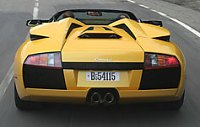 Because
the big Lambo was not designed for roofless from the beginning,
Lamborghini
did quite a lot of modification to the chassis and body structure. To
compensate
the loss of roof, there are some chassis reinforcements, most notably
is
a steel (or optional carbon fiber) engine cage bolted over the V12. It
strengthens the connection between firewall and the rear engine /
suspension-mounting
frame. Behind the occupants are a pair of pop-up rollover bar, adapted
from Audi A4 Cabriolet. For better integration of rollover mechanism,
the
engine cover has been converted to rear-hinged, just like the classic
Muria.
Because
the big Lambo was not designed for roofless from the beginning,
Lamborghini
did quite a lot of modification to the chassis and body structure. To
compensate
the loss of roof, there are some chassis reinforcements, most notably
is
a steel (or optional carbon fiber) engine cage bolted over the V12. It
strengthens the connection between firewall and the rear engine /
suspension-mounting
frame. Behind the occupants are a pair of pop-up rollover bar, adapted
from Audi A4 Cabriolet. For better integration of rollover mechanism,
the
engine cover has been converted to rear-hinged, just like the classic
Muria.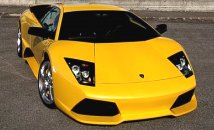 In
the past few years, the "baby Lambo" Gallardo has been the highlight of
Sant'Agata due to its mass market appeal and commercial success.
However, Murcielago is still the flagship, the definitive Lamborghini
and the direct successor from the breed of Diablo and Countach. This
year the big Lambo is 5 years old. It is time for a facelift and engine
upgrade.
In
the past few years, the "baby Lambo" Gallardo has been the highlight of
Sant'Agata due to its mass market appeal and commercial success.
However, Murcielago is still the flagship, the definitive Lamborghini
and the direct successor from the breed of Diablo and Countach. This
year the big Lambo is 5 years old. It is time for a facelift and engine
upgrade. 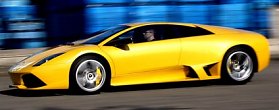 From
the sound you can hear the difference: it becomes edgier, higher pitch
and more frantic than the deep throated roar of the old engine. From
3500 rpm the engine roars angrily accompany with a power kick. From
5000 rpm it thunders and delivers breathtaking g-force. Being even
louder than the old V12, the 6.5-litre engine is a beast compare with
the smooth and linear Ferrari V12. In fact, their characters are well
illustrated by their company logos - Bull and Prancing Horse.
From
the sound you can hear the difference: it becomes edgier, higher pitch
and more frantic than the deep throated roar of the old engine. From
3500 rpm the engine roars angrily accompany with a power kick. From
5000 rpm it thunders and delivers breathtaking g-force. Being even
louder than the old V12, the 6.5-litre engine is a beast compare with
the smooth and linear Ferrari V12. In fact, their characters are well
illustrated by their company logos - Bull and Prancing Horse.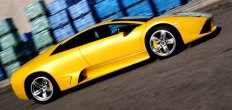 In
contrast to the exterior, the tubular steel chassis remains untouched,
so does the viscous-coupling 4-wheel-drive system. This mean the big
Lambo is still a heavyweight supercar - 1665 kg in dry. Ferrari 599 GTB
undercuts it by 85 kg yet provides far more usable space and
convenience.
In
contrast to the exterior, the tubular steel chassis remains untouched,
so does the viscous-coupling 4-wheel-drive system. This mean the big
Lambo is still a heavyweight supercar - 1665 kg in dry. Ferrari 599 GTB
undercuts it by 85 kg yet provides far more usable space and
convenience.